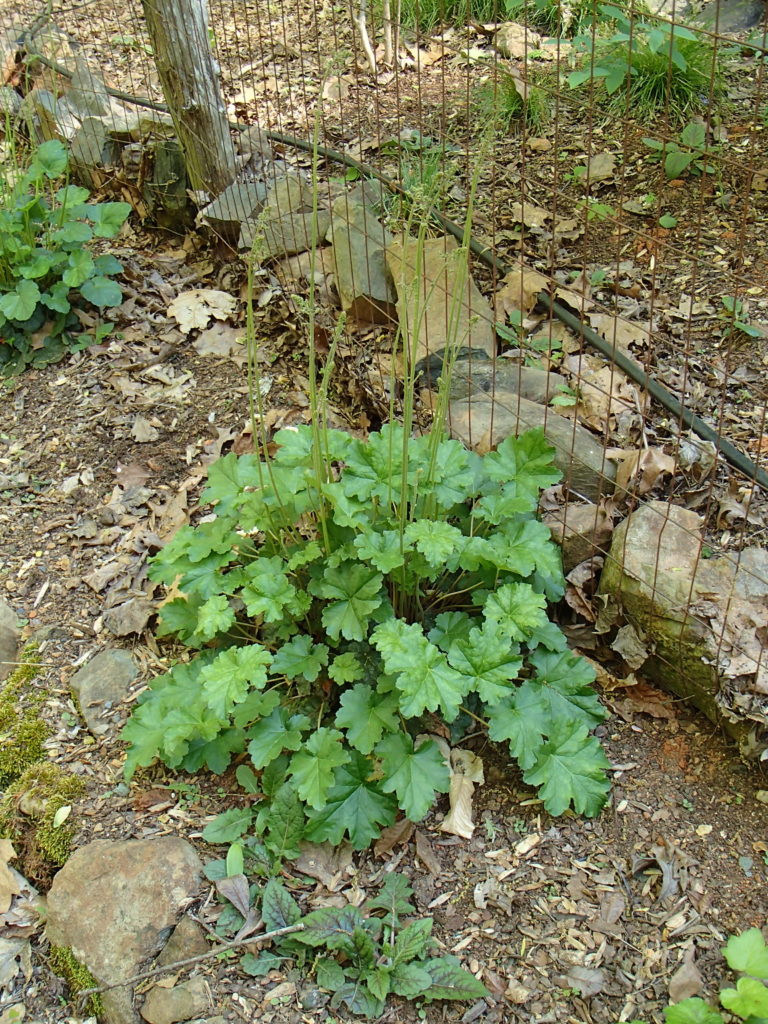Heuchera, or Alumroot, or Coral Bells is a wonderful, low, evergreen perennial with beautiful foliage which remains attractive year ’round if its cultural requirements are met. It does flower, but is often grown purely for its rich, patterned foliage which shows a wide array of leaf colors, patterns, shapes, and sizes. The flowers are not strikingly showy, but they do add a touch of airiness to the feel. Well spaced (18″), Heuchera serves as a ground cover, especially along borders, and will add a lush texture to any shade garden. Leaf coloration is best with more sun, but in the heat of our piedmont climate some shade, particularly in the afternoon, is necessary to prevent scorching. Overall, it grows best in part shade or filtered sun, in moist, well drained, humus-rich soil. Plants require good drainage and tolerate drought and rocky soils. It is a tidy plant, and looks great in a container on the deck. The plant is native to central and eastern North America and in NC, grows mostly in mountain and piedmont counties.
NURSERY HOURS
Wednesday: 10-4 Thursday: 10-6 Friday-Saturday: 10-4 Sunday: 12-4
Heuchera americana

Key Info
Scientific Name: Heuchera americana L.
Common Names: American Alumroot, Coral Bells
Family Names: Saxifragaceae (Saxifrage Family)
Plant Type: Herbaceous perennial
Leaf Retention: Evergreen
Flower Color: Green/cream
Special Characteristics: Tolerates drought, Reported to be deer resistant., Tolerates Black Walnut, Ornamental foliage, Tolerates shade
Additional Info
Habit: This plant presents as a mounded rosette of attractive foliage 6-12” tall with 18” or greater spread, with loose panicles of insignificant green to cream flowers towering above to a height of 2-3’ in midsummer. The leaves emerge in a dense spiral from a short central crown which rises above ground as plants mature. Plants have shallow, fibrous root systems.
Height: 1'-2'
Spread: 1' - 1.5'
Soil Conditions: Average to dry moisture; circumneutral pH; sandy, loamy, clay
Leaves: Basal leaves are rounded/heart-shaped, shallowly lobed, roughly textured, and often white- or bronze-mottled (especially in selections or cultivars). They are 3-5" wide, with blunt teeth and long slender petioles. The leaves emerge variegated in shades of purple, bronze or cream, marbled or veined in conspicuous palmate venation, and mature to a more uniform green.
Flowers (or reproductive structures: In late spring to early summer, tiny, green to cream, scentless, bell-shaped flowers with exerted stamens, occur in open, airy 3-8-inch panicles supported on slender, leafless, wiry peduncles to 2-3 feet, well above the mound of leaves.
Fruit: Numerous tiny, lustrous seeds are formed in small, beaked, dark brown capsules 3-4 weeks after flowering.
Natural Distribution: Generally high quality habitats in dryish locations in rocky, open woodlands and along ledges and crevices of bluffs; crevices or ledges of basic rock outcrops and calcareous woodlands.
USDA Hardiness Zone: 4 to 9
USDA Wetland Indicator Status in NC: FACU
Pollination: Bees, butterflies, other insects
Wildlife Connections: Attracts native pollinators; unpalatable to mammalian herbivores.
Propagation: By division or by seed.
